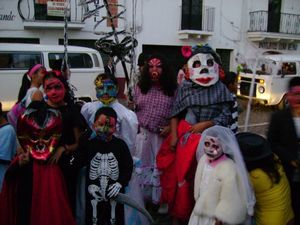Advertisement
Published: October 27th 2011

 Dias de los Muertos
Dias de los Muertos
Mexican family out enjoying Days of the Dead celebrations.At first glance, Mexico's Days of the Dead celebrations (which fall on November 1st and 2nd annually) seem like a different take on Halloween. There are people in costume, and they seem to be connecting with the shadow side of life dressed in costumes like skeletons (calaveras) or devils (diablos). Besides these basic similarities, however, the two holidays couldn't be more different.
On my first trip to Mexico I was struck by the unaffected attitude the Mexicans have towards death. First of all, this is not a country that seems overly concerned with health and/or safety. There's no Public Health Board stepping into every restaurant or checking up on food vendors to make sure that the food is property handled. You're expected to jump on and off moving buses if you're a strapping young man like me and the police walk around holding gigantic assault rifles in front of them. People are unfazed by the newspapers (if you can call them that) that always seems to feature a photograph of bloodied and bullet-ridden corpses lying on a street after a public display of gang violence. Finally, there are skulls everywhere, but they aren't only the property of punk or pirate

 Our Day of the Dead Costumes
Our Day of the Dead Costumes
Our Day of the Dead costumes.types. Skulls are not considered a frightening or vulgar sight to Mexicans; in this way the Day of the Dead celebrations are as much about living as they are about dying. The Day of the Dead holiday is an opportunity to welcome the dead back to the world of the living, to reconnect and party with loved ones who have departed the physical world.
Pulitzer prize-winning author Octavio Paz said of Mexicans in his book of essays 'The Labyrinth of Solitude', "The Mexican is familiar with death, jokes about it, caresses it, sleeps with it, and celebrates it. It is one of his favourite playthings and his most steadfast love." This holiday is a perfect example of the mish-mash of cultures found in Mexico as a result of the mixture of indigenous and Spanish beliefs. Mayan and Aztec traditions viewed death as a benign resting space where there ancestors could calmly wait to be called up to the land of the living for the Day of the Dead.
Production planning for the Day of the Dead is an all-year thing, and if you're lucky enough to be in Mexico at this time of year like I was, you'll see

 Calavera
Calavera
Homemade Calaverathat even families with very modest incomes pull out all the stops for the deathly occasion. The occasion calls for a certain degree of organization;
inventory management, even. Every home set up an altar adorned with photographs, candles, incense, flowers (especially marigolds) and of course, calaveras. A candle is lit for each deceased family member and their favourite types of alcohol, sweets and other
organic ingredients.
I really like the Mexican attitude towards death, and I don't think it's irreverent. While other cultures depict death as a 'Grim Reaper', Mexican skeletons are colorful, smiling and playful. Death is flirted and danced with, and loses its menacing meaning in play.
Advertisement
Tot: 0.073s; Tpl: 0.009s; cc: 14; qc: 28; dbt: 0.0373s; 1; m:domysql w:travelblog (10.17.0.13); sld: 1;
; mem: 1mb

 Dias de los Muertos
Dias de los Muertos
 Our Day of the Dead Costumes
Our Day of the Dead Costumes
 Calavera
Calavera
